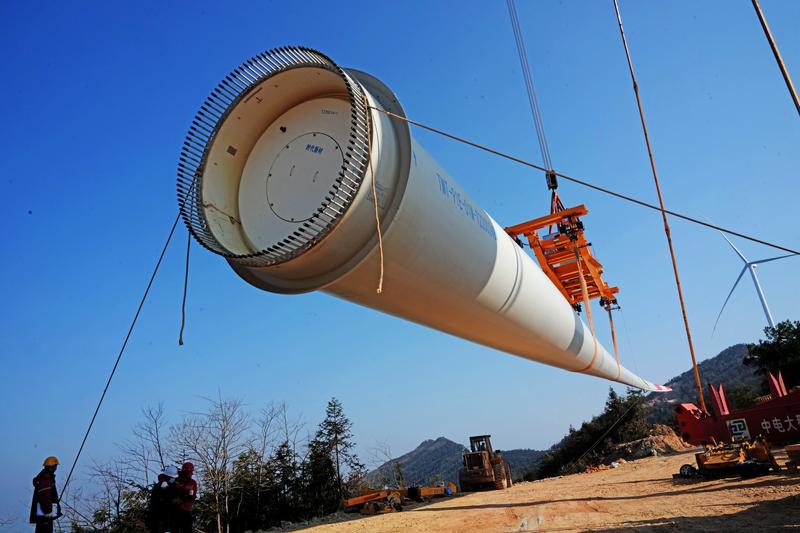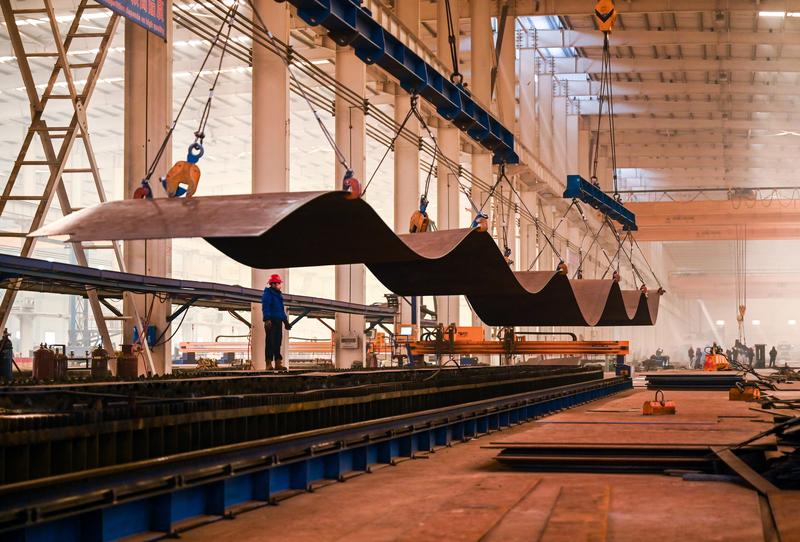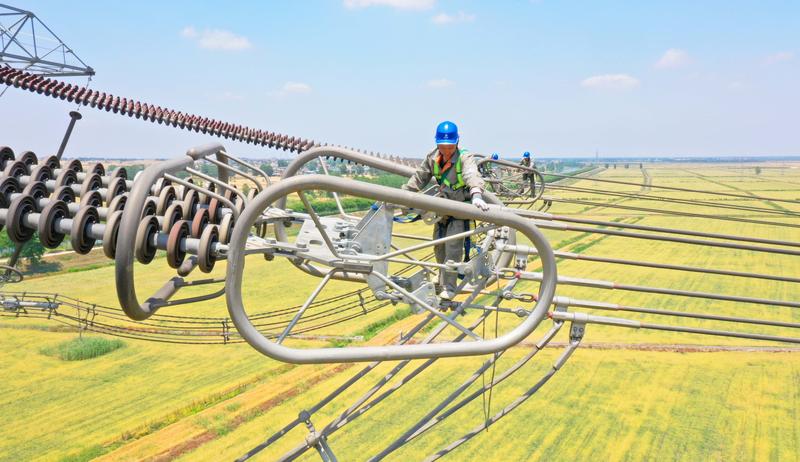New electricity networks are being built to bring renewable energy to the nation's major urban and manufacturing areas. Hou Liqiang reports.
 Employees of Inner Mongolia Datang International Tuoketuo Power Generation install a generator fan last month. (PHOTO PROVIDED TO CHINA DAILY)
Employees of Inner Mongolia Datang International Tuoketuo Power Generation install a generator fan last month. (PHOTO PROVIDED TO CHINA DAILY)
Cooperation between paired eastern and western regions — in which prosperous regions provide assistance to underdeveloped areas — has proved to be an effective approach that helped China declare victory in its battle against extreme poverty in February 2021.
As the country forges ahead with its ambitious and arduous targets of peaking carbon dioxide emissions before 2030 and realizing carbon neutrality before 2060, the pairing mechanism is likely to play a significant role once again.
This time, though, support is being offered by the west of the country — which is sparsely populated but home to rich renewable resources — to the densely populated, power-thirsty eastern areas.
Irrespective of the direction, the result of such cooperation is still a win-win outcome.
In the country's poverty eradication campaign, Beijing is paired with the Inner Mongolia autonomous region and Hebei province.
According to the Beijing government, in 2016-17, the capital provided more than 2 billion yuan ($290 million) in funds to support the two provincial-level regions in their poverty relief endeavors.
In total, the support, which aided implementation of 350 projects, helped lift 470,000 people out of poverty. Now, the two regions are paying Beijing back and helping make the city even greener.
 A fan blade is lifted at a wind farm in Liuzhou, Guangxi Zhuang autonomous region, in January. (LONG TAO / FOR CHINA DAILY)
A fan blade is lifted at a wind farm in Liuzhou, Guangxi Zhuang autonomous region, in January. (LONG TAO / FOR CHINA DAILY)
Development bases
The 2022 Beijing Winter Olympics and Paralympics Games were the first such events at which every venue was supported by renewable energy. The feat was made possible by a flexible direct current power grid that connected Beijing with a renewable energy demonstration zone in Hebei's Zhangjiakou city, which boasts rich wind and solar resources.
Having started operations in June 2020, the grid can transmit 22.5 billion kilowatt-hours of renewable power to Beijing every year, roughly 10 percent of the capital's annual electricity needs. That helps to reduce carbon dioxide emissions by more than 20 million metric tons per annum.
Last year, the capital also established a cooperation mechanism for the development of green electricity with Inner Mongolia, according to Mu Peng, head of the Beijing Commission of Development and Reform.
Construction of a new energy development base that will serve Beijing as one of its customers has started in Togtoh, a county in Hohhot, Inner Mongolia's capital, Mu said when he reported to the first session of the 16th Beijing Municipal People's Congress in January.
A major project at the base is a wind and solar power plant with total installed capacity of 2 million kilowatts. Construction began in June and the plant is expected to become fully operational by the end of this year, said Yuan Dongsheng, general manager of Inner Mongolia Datang International Tuoketuo Power Generation, the company building the facility.
 Staff members work on a production line at an industrial park in Tongliao, Inner Mongolia autonomous region, in January. (PHOTO / XINHUA)
Staff members work on a production line at an industrial park in Tongliao, Inner Mongolia autonomous region, in January. (PHOTO / XINHUA)
When completed, the project, with total investment of some 12 billion yuan, will generate more than 4.1 billion kWh of electricity a year, cutting the use of standard coal by 1.4 million tons and reducing carbon dioxide emissions by 3.5 million tons, according to Yuan.
"By establishing a green, low-carbon, clean and highly efficient energy system, the project will help Beijing and Inner Mongolia accelerate their efforts to peak carbon dioxide emissions and become carbon neutral," he said.
Yuan added that the project will also help drive economic growth in the area.
Construction of the base has injected impetus into the development of the new energy program and the introduction of manufacturing industries for renewable energy equipment, thus driving the upgrading of Hohhot's energy sector, he said.
During the construction period, more than 2,000 workers are expected to be employed. Once it becomes operational, the plant will bolster local tax revenue, he said.
He added that the project will also raise the utilization rate of land resources in the surrounding rural areas.
In 2021, Inner Mongolia sent 50 billion kWh of renewable energy to other regions, about 20 percent of the total power it transferred that year, according to the regional development and reform commission in response to questions from China Daily.
 Solar silicon wafers are packed in Dongying, Shandong province, in January. (PHOTO / XINHUA)
Solar silicon wafers are packed in Dongying, Shandong province, in January. (PHOTO / XINHUA)
New projects
The Togtoh base is just one of three renewable energy projects under construction in Inner Mongolia that will serve Beijing, the commission said.
Moreover, the region is forging ahead with the necessary procedures to start another planned renewable project with installed capacity of more than 10 million kW, as well as two planned power transmission lines.
The commission is actively "coordinating local governments and energy companies to make all-out efforts to guarantee the green electricity supply to the capital by accelerating the implementation of these projects", it said.
When all of the projects are completed, they are expected to generate almost 13.8 billion kWh of green power a year, the commission said. That will see the use of standard coal reduced by 4 million tons and carbon dioxide emissions will fall by 11.4 million tons a year.
Authorities in Beijing and Inner Mongolia have had frequent meetings about another even larger renewable energy base with a total installed capacity of 10 million kilowatts in Xiliin Gol League, one of the prefecture-level areas in Inner Mongolia closest to Beijing.
At a work conference to coordinate paired assistance between Beijing and Inner Mongolia, held in the autonomous region in July, the regions fully endorsed the Xiliin Gol League project, according to a statement from the league's government to China Daily.
The heads of Inner Mongolia and Beijing asked the departments under their jurisdiction to accelerate the development of the project, it said.
In November, the heads met again in Beijing to promote the paired assistance program. As a result of the meeting, the Inner Mongolia authorities will sign a framework agreement with Beijing Energy Holding to support projects in which the company invests in the autonomous region, including the Xiliin Gol League project.
The document has already been signed by the Beijing company, and it was sent to the autonomous region's development and reform commission and energy administration in January, it said. The two departments are undertaking official procedures to give it the green light.
The government of Xiliin Gol League said the project, which has total investment of approximately 38.7 billion yuan, will include a flexible direct current power grid that will transmit power directly to the capital.
According to a 2021-25 energy development plan issued by the Beijing government, the Chinese capital will work to raise the amount of green power brought in from outside to 30 billion kWh by 2025.
The amount of green electricity transmitted to Beijing from other regions reached more than 18 billion kWh in 2021, compared with 720 million in 2013, according to Lai Xianyu, deputy head of the Beijing Commission of Development and Reform.
The increase was achieved because Beijing supported its energy companies in building large-scale renewable energy bases outside of the capital and also because the city has signed strategic cooperation agreements with several regions to boost cross-regional power transmission in a concerted manner, he said.
 Engineers conduct an annual inspection of transmission lines at an altitude of 120 meters in Mingguang, Anhui province. (SONG WEIXING / FOR CHINA DAILY)
Engineers conduct an annual inspection of transmission lines at an altitude of 120 meters in Mingguang, Anhui province. (SONG WEIXING / FOR CHINA DAILY)
Wider cooperation
Shandong province in East China and Gansu province in Northwest China — whose paired assistance on poverty relief has already yielded significant results — will join hands again in the campaign for carbon neutrality.
When delivering the work report to the first session of the 14th Gansu Provincial People's Congress in January, provincial Governor Ren Zhenhe highlighted a Gansu-Shandong power transmission project that was launched last year.
Gansu will further tap its rich energy resources this year, he said.
To make the province a major clean energy production zone, Gansu will complete construction of a number of national — and provincial-level wind and solar energy bases, while advancing construction of pumped storage power stations and comprehensively promoting the Gansu-Shandong project, he said.
Pumped storage power stations pump water to reservoirs at higher locations by using surplus green electricity during off-peak consumption periods, then regenerate to meet emerging power needs, which is regarded as a cost-effective way of addressing the intermittent nature of wind and solar power generation.
According to the Gansu authorities, the province has made progress in a demonstration renewable energy project that will support power transmission to Shandong.
The first wind-driven generator for the 6-million-kilowatt renewable energy project, which combines facilities for wind and solar power generation, as well as renewable energy storage, was installed at a mega energy base in Gansu's Qingyang city on Nov 30.
The 40-billion-yuan-plus project is expected to generate 14 billion kWh of clean electricity a year, which means 4.2 million tons of standard coal will be saved and carbon dioxide emissions will be cut by 11 million tons.
The plant will be completed and put into operation together with the Gansu-Shandong transmission line during the middle stages of the 14th Five-Year Plan (2021-25) period.
Next year, Shandong will make further efforts to accept more green power from other regions and will raise the amount of renewable electricity it receives from other regions to around 125 billion kWh, according to Zhou Naixiang, Shandong's governor, when he delivered the work report to the 14th Shandong Provincial People's Congress in January.
Sun Ruisheng in Taiyuan contributed to this story.
Contact the writer at houliqiang@chinadaily.com.cn


